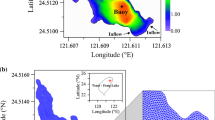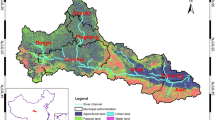Abstract
Suspended sediments, one of the most important factors affecting the water environments of inland lakes, are closely related to the migration and interaction of various pollutants. Existing studies show that the suspended sediment concentration can be accurately predicted based on assimilation methods coupled with hydrodynamic models. However, in the hydrological assimilation simulation process, the existing perturbation generation methods consider the perturbation error to follow a random Gaussian distribution, which does not consider the spatial variation characteristics of errors. Thus, in this paper, we proposed a new method that generates a hybrid perturbation field for the assimilation simulation instead of using random error. The proposed approach was validated through assimilation simulations of the suspended sediment concentration of Taihu Lake, China, and five assimilation experiments were conducted. The proposed method was compared with the existing methods for generating the perturbation field. After three days and 72 time steps of assimilation simulation based on the hybrid perturbation field, the proposed assimilation method provided results that were more consistent with the buoy-measured data. These findings demonstrate that the proposed method for generating a hybrid perturbation field has a higher simulation accuracy than other methods and is therefore effective and provides a new idea for the assimilation simulation of suspended sediment concentrations in inland lakes.






Similar content being viewed by others
Data Availability
High-resolution underwater terrain data were provided by the Chinese government; the authors do not have the right to make these data publicly available on the Internet. The meteorological data and other model simulation data sets used in this study are available from the corresponding author upon reasonable request.
Code availability
The MATLAB code for assimilation and FORTRAN code for the dynamic model of this study are available from the corresponding author upon reasonable request.
References
Bishop CH, Etherton BJ, Majumdar SJ (2001) Adaptive sampling with the ensemble transform Kalman Filter. Part I: Theoretical aspects. Mon Weather Rev 129(3):420–436
Bright C, Mager S, Horton S (2020) Response of nephelometric turbidity to hydrodynamic particle size of fine suspended sediment. Int J Sedim Res 35:444–454
Burgers G, Jan Van Leeuwen P, Evensen G (1998) Analysis scheme in the ensemble Kalman Filter. Mon Weather Rev 126(6):1719–1724
Chen C, Liu H, Beardsley RC (2003) An unstructured grid, finite-volume, three-dimensional, primitive equations ocean model: Application to coastal ocean and estuaries. J Atmos Oceanic Tech 20(1):159–186
Chen C, Xiang LI, Hongrang HE et al (2018) Algorithm based on local breeding of growing modes for convection-allowing ensemble forecasting. Sci China Earth Sci 61(4):1–11
Clark MP, Rupp DE, Woods RA et al (2008) Hydrological data assimilation with the ensemble Kalman filter: Use of streamflow observations to update states in a distributed hydrological model. Adv Water Resour 31(10):1309–1324
Daneshfaraz R, Kaya B (2008) Solution of the propagation of the waves in open channels by the transfer matrix method. Ocean Eng 35(11–12):1075–1079
Evensen G (2003) The ensemble Kalman Filter: theoretical formulation and practical implementation. Ocean Dyn 53(4):343–367
Friese K, Schmidt G, Lena JCD et al (2010) Anthropogenic influence on the degradation of an urban lake – The Pampulha reservoir in Belo Horizonte, Minas Gerais. Brazil Limnologica 40(2):114–125
Hoffman RN, Kalnay E (2010) Lagged average forecasting, an alternative to Monte Carlo forecasting. Tellus A 35a(2):100–118
Hollingsworth CG, Heydrick FP (1980) Investigator initiated multi-center clinical trials and the national institutes of health. Control Clin Trials 1(2):179–180
Huang C, Yang H, Zhu AX et al (2015) Evaluation of the Geostationary Ocean Color Imager (GOCI) to monitor the dynamic characteristics of suspension sediment in Taihu Lake. Int J Remote Sens 36(15–16):3859–3874
Kim J, Yoo J, Do K (2020) Wave data assimilation to modify wind forcing using an ensemble Kalman Filter. Ocean Science Journal 55:231–247
Kouakou KL, Kouame KI, Konan KS et al (2013) Two-dimensional numerical simulation of the hydro-sedimentary phenomena in Lake Taabo, Côte d’Ivoire. Water Resour Manage 27:4379–4394
Leith CE (1974) Theoretical skill of Monte Carlo forecasts. Mon Weather Rev 102(6):409
Majumdar SJ, Chen SG, Wu CC (2015) Characteristics of Ensemble Transform Kalman Filter adaptive sampling guidance for tropical cyclones. Q J R Meteorol Soc 137(655):503–520
Pang Y, Zhuang W, et al (2008) Experiment and model simulation of suspended solids in Taihu Lake under wind-wave disturbance. Environmental Science (China)10:2743–2748
Politano M, Martin JE, Lyons T, Dober K (2020) Numerical modelling of the hydrodynamics and sediment transport near the water intake of the Cardinal power plant. J Hydraul Res 58:859–866
Shokri A, Walker JP, Dijk AIJM, Pauwels VRN (2019) On the use of adaptive Ensemble Kalman Filtering to mitigate error misspecifications in GRACE data assimilation. Water Resour Res 55:7622–7637
Song C, Shi X, Wang J (2020) Spatiotemporally Varying Coefficients (STVC) model: a Bayesian local regression to detect spatial and temporal nonstationarity in variables relationships. Ann GIS 26:277–329
Toth Z, Kalnay E (1997) Ensemble forecasting at NCEP and the breeding method. Mon Weather Rev 125(12):3297–3319
Vrugt JA, Gupta HV, Nualláin BÓ et al (2006) Real-time data assimilation for operational ensemble streamflow forecasting. J Hydrometeorol 7(3):548
Wei L, Huang C, Zhong Y et al (2019) Inland waters suspended solids concentration retrieval based on PSO-LSSVM for UAV-Borne hyperspectral remote sensing imagery. Remote Sensing 11(12):1455
Wu J, Zeng H, Yu H et al (2012) Water and sediment quality in lakes along the middle and lower reaches of the Yangtze River. China Water Resources Management 26(12):3601–3618
Zhang Z, Huang C, Guo F, et al (2019) A new technology for suspended sediment simulation in Lake Taihu, China: Combination of hydrodynamic modeling and remote sensing. J Limnol 121–134
Funding
This work was supported by the National Natural Science Foundation of China (No. 41571386 and No. U1811464) and the Priority Academic Program Development of the Jiangsu Higher Education Institutions (PAPD).
Author information
Authors and Affiliations
Contributions
The method was conceived by Fei Guo and A-xing Zhu, and the experiments were designed by Fei Guo and A-xing Zhu and performed by Jingjia Zhang. The algorithm was conceived, implemented and optimized by Fei Guo, Jingjia Zhang, Zhuo Zhang and Hong Zhang. Fei Guo and Jingjia Zhang took part in writing the paper. A-xing Zhu provided critical review and substantially revised the manuscript. All authors read and approved the final manuscript.
Corresponding author
Ethics declarations
Ethical Approval
This paper mainly studies the natural environment of inland lakes, and all analyses were based on previously published studies; thus, ethical approval was not required for this research.
Consent to Participate
This paper mainly studies the natural environment of inland lakes, and all analyses were based on previously published studies; thus, consent to participate was not required for this research.
Consent to Publish
The manuscript has been approved by all authors for publication.
Competing interests
The authors declare that they have no competing interests.
Additional information
Publisher's Note
Springer Nature remains neutral with regard to jurisdictional claims in published maps and institutional affiliations.
Rights and permissions
About this article
Cite this article
Guo, F., Zhang, J., Zhu, Ax. et al. An Assimilation Simulation Approach for the Suspended Sediment Concentration in Inland Lakes Using a Hybrid Perturbation Generation Method. Water Resour Manage 35, 2007–2022 (2021). https://doi.org/10.1007/s11269-021-02827-1
Received:
Accepted:
Published:
Issue Date:
DOI: https://doi.org/10.1007/s11269-021-02827-1




